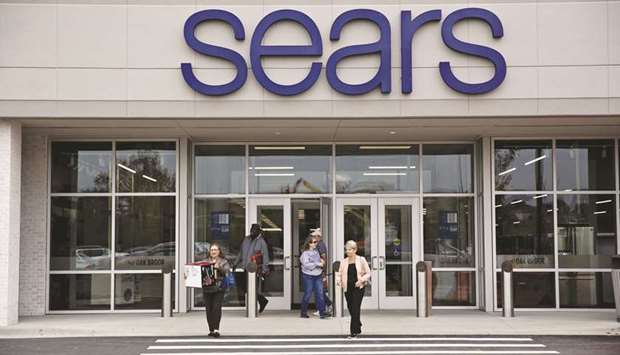Sears Holdings Corp, the 125-year-old retailer that became an icon for generations of American shoppers, filed for bankruptcy, saddled with billions of dollars of debt racked up as it struggled to adjust to the rapid shift toward online consumption.
The company filed for Chapter 11 protection from creditors with the US Bankruptcy Court in White Plains, New York, early yesterday and said Eddie Lampert is stepping down immediately as chief executive officer. At the same time, Lampert’s ESL Investments Inc is negotiating a financing deal while also discussing buying “a large portion of the company’s store base,” Sears said in a statement.
The retailer, for years called Sears, Roebuck & Co and famous for its massive catalogue, boomed in the decades after World War II along with a growing middle class. But it wasn’t able to keep up with shifting consumer habits as online rivals including Amazon.com Inc siphoned off shoppers, while turnaround efforts were hobbled by mountains of debt.
Sears, which sold everything from Craftsman tools to Kenmore appliances, lost its footing in the 1980s with expansions into financial products such as banking, mortgages, insurance and credit cards. Walmart Inc supplanted Sears as the biggest retailer in the early 1990s.
The retailer listed more than $10bn in debts and more than $1bn in assets in its filing, and said it is seeking to reorganise around a smaller base of profitable stores. Sears and Kmart stores will remain open with help from $600mn in new loans, but the company will shut 142 unprofitable outlets near the end of the year, on top of 46 unprofitable stores already slated for closure by November.
For now, Sears will be run by an Office of the CEO, and independent directors will oversee the restructuring. Lampert, who is Sears’s biggest shareholder and will remain as chairman, acknowledged in the statement that turnaround efforts so far have fallen short.
“While we have made progress, the plan has yet to deliver the results we have desired, and addressing the company’s immediate liquidity needs has impacted our efforts to become a profitable and more competitive retailer,” Lampert said.
The company already has commitments for $300mn of debtor-in-possession financing from its senior secured asset-based revolving lenders, according to the statement, and it’s negotiating a $300mn subordinated DIP financing with ESL. The hedge fund held about $2.5bn in Sears debt as of September, the result of multiple attempts to keep the chain afloat.
ESL said in April it would be open to buying some of the company’s assets and urged the department store to put the businesses on the block. It said in a statement yesterday it had proposed as recently as September a strategic plan that would include selling assets, including those ESL was seeking to purchase.
“While a comprehensive out-of-court resolution was ESL’s preferred approach, it did not prove possible to achieve this outside the framework of a Chapter 11 process,” ESL said.
Lampert tried multiple strategies to revive Sears since using the Kmart chain to acquire Sears in 2005, sometimes with his own money. He’s shuttered hundreds of money-losing stores, cut more than $1bn in annual expenses, and spun off units such as Lands’ End.
Parts of Sears have already been through bankruptcy. Sears Canada Inc liquidated a year ago and about 12,000 people lost their jobs. Lampert partially spun off the company from its parent in 2012 and was Sears Canada’s biggest shareholder.
The company was started by Richard Sears, a train station agent in Minnesota who began selling watches by mail in 1886, according to the company’s website. He soon partnered with watch repairman Alvah Roebuck.

Shoppers exit a newly renovated Sears Holdings store in Oak Brook, Illinois. Sears filed for Chapter 11 protection from creditors with the US Bankruptcy Court in White Plains, New York, early yesterday and said Eddie Lampert is stepping down immediately as chief executive officer.
